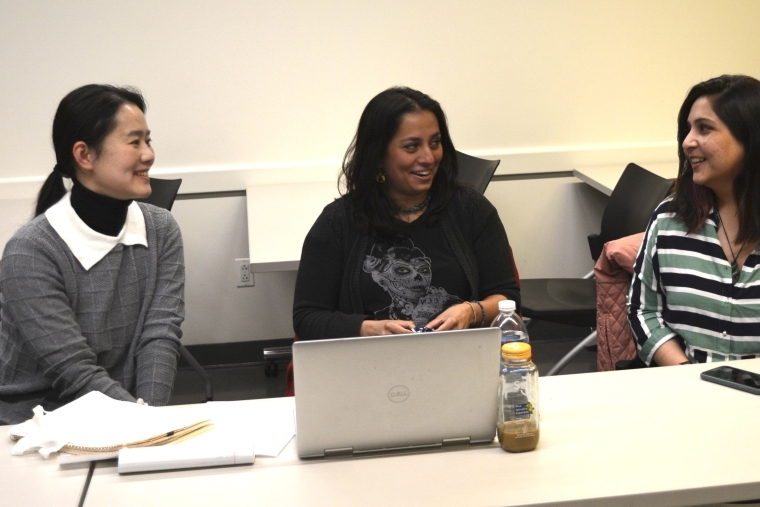
Andrew White and Dr. Basilio G. Monteiro, Ph.D.
As the communication industry evolves, so do the educational opportunities at St. John’s University.
The University’s new doctoral program in Multi-Sector Communication, prepares students for innovative careers in an industry that is always changing. Developed by Basilio G. Monteiro, Ph.D., Associate Professor, Division of Mass Communication, and Director, M.S. in International Communication degree program, its cross-departmental nature reflects the vast influence of media and communication across society.
“Communication is more than just how you choose your words,” Dr. Monteiro said. “Without communication, nothing in society happens, so we explore all aspects of society—politics, economics, diplomacy, and international relations—through the lens of communication.”
Dr. Monteiro, who is also Director of the University’s Institute for International Communication, began work on the program in 2018 and it launched with nine students in Spring 2021. Enrollment grew to 13 students that fall. Enrollment for Fall 2022 continues.
“Nowadays, communication is not one clear-cut industry,” said Ph.D. candidate Tara DeWorsop, a 35-year-old nonprofit development professional from Brooklyn, NY.
“We look at how things like social media can impact global policy and how communication can impact a number of different sectors. This program helps you think about communication in a different way.”
A graduate of Rutgers University with a B.A. in Cultural Anthropology and an M.B.A. from New York University, Tara was attracted by the diversity of St. John’s Ph.D. program. She has about 18 months of study remaining. In the meantime, she and several colleagues will deliver a paper on the impact of global disinformation as part of a research symposium at St. John’s Rome, Italy, campus this summer.

Joining her will be Andrew White, a 39-year-old higher education administrator from Richmond Hill, Queens. A holder of two master’s degrees, Andrew appreciates the opportunity to work with Dr. Monteiro, whom he calls “one of the best human beings” he’s ever met.
“When I heard he was starting a multisector communication Ph.D. program, I asked, ‘what’s that?’” Andrew said. “But I saw a connection to not only the field of communication, but to a whole other series of industry needs. The program offers a thorough analysis of how so many aspects of industry are interwoven and how media impacts that.”
The program is open to those with a master’s degree. Thirty post-master’s credits are required in courses that range from crisis communications, science and technology studies, data analysis, economics, and more. Dr. Monteiro said the program is ideal for those considering careers in corporate and strategic communication, communication technology, and in the academic sector.
Students receive an additional six credits for completion of a dissertation. Full-time students can complete the Ph.D. program in three to 3 ½ years or possibly sooner; part-time students can complete the program in five to 5 ½ years.
The program at St. John’s is modeled after similar programs at the London School of Economics and the University of Leicester in England, and is an ideal fit for working professionals, Dr. Monteiro said. The entire cohort meets with him weekly on Wednesday evenings.
“For some, Ph.D. programs in the United States can be burdensome in terms of time and cost,” Dr. Monteiro said, describing the advantages of the St. John’s program.
The program draws students from a variety of backgrounds. Included in the 2022 mix of students are diplomats, economists, attorneys, engineers, clergy, and several who aspire to careers in academia.
Dr. Monteiro attributed the diversity of student backgrounds to the forward-looking nature of the curriculum. “Media is always emerging,” he explained. “Where it is going next is the question to be explored.”
Related News
Institute for Catholic Schools Provides Educational Resources to Local Catholic School
The Institute for Catholic Schools (ICS) in The School of Education at St. John’s University recently donated approximately $2,800 worth of academic and sensory learning tools to Father Vincent...
Meet Anna R. Lukachik ’80Ed, Pietas Medal Recipient
At St. John’s University’s annual Alumni Convocation on October 18, Anna R. Lukachik ’80Ed received the Pietas Medal, an award that honors exceptional alumni for their service and achievements...
Henry George Lecture Focuses on Economic Responses to Climate Change
The potential of a carbon wealth tax (CWT) to mitigate the continuing threat posed by climate change was the subject of St. John’s University’s semiannual Henry George Lecture Series, hosted by The Peter J. Tobin College of Business on October 30.
